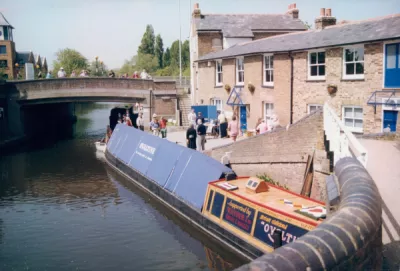Ovaltine
A Wander & Sons Ltd of Kings Langley, on the northern edge of Three Rivers.

Ovaltine, a well-known hot drink, became something of a national institution in Britain towards the middle of the twentieth century
The Ovaltinies radio broadcasts from Radio Luxembourg extolled the health-giving benefits of the drink. The show, broadcast at 5.30 on a Saturday before most people had television, was created especially for children and included singing, secret codes, puzzles and stories. The Ovaltineys became a special club, and gained over 5 million members in its first four years. Children applied for membership using forms found inside Ovaltine tins. They were sent a badge, a rule book, secret code and a list of special rules that all members needed to abide by.
Ovaltine continued to grow in popularity throughout the twentieth century. It was the official drink of the 1948 Olympics, with 25,000 cups served to the competitors, and was also carried up Mount Everest by Sir Edmund Hillary in 1953. The company became the largest liquid malt extract producer in the world, and it was not only used in Ovaltine, but in the inside of Maltesers, biscuits and sweets. Ovaltine was also available in the form of chocolate bars, Easter eggs, cookies and breakfast cereals.
It was a real national icon.
Yet Ovaltine is of Swiss origin. Created in the 1860s by Dr George Wander, a Swiss chemist wishing to promote the nutritional value of barley malt, it didn't arrive in the UK until the early 1900s. George's son Albert, who had succeeded his father in the business in 1900, developed export markets for the drink, and formed a British company to sell and manufacture Ovaltine in England. A small factory was built at Kings Langley, on the Three Rivers bank of what was then the Grand Junction Canal, and production began here in 1913. So successful was the business that a much larger factory was built on the site between 1924-29.
Wander was concerned that his suppliers might not be able to keep pace with the company's demand for barley, eggs and milk. To ensure that this didn't restrict the company's growth, in 1929 he bought two farms close to the factory: Numbers Farm at Kings Langley and Parsonage Farm at Abbots Langley totalled around 450 acres. As well as being farmed commercially to provide the natural ingredients for Ovaltine, they became an important part of the company's marketing strategy. Known as the Model Poultry and Dairy Farms, they were rebuilt in precise imitation of the farm the French King Louis XVI built for Queen Marie Antoinette, and featured regularly in the company's advertising to promote the drink's wholesome qualities.
By the mid-20th Century, the company was employing close to 1500 people at Kings Langley. You can read here the memories of a lady who worked there during WW2, which include both Ovaltine and local history elements.
As agricultural methods improved and advertising techniques changed, the farms became less important to the company. The availability of ingredients in sufficient quantity was no longer a concern, and larger farms could produce them more cheaply, while the wholesome image projected by the farm buildings began to look rather dated. The company also began to diversify into other product lines such as Options chocolate-flavoured drinks, in which the Ovaltine name featured less prominently.
The farm buildings, now unused, began to deteriorate and eventually the company decided to sell them. In the early 1990s, the buildings of Parsonage Farm (the dairy farm), situated just off Bedmond Road in the centre of Abbots Langley, were converted to residential use and are now known as Antoinette Court. The buildings of the egg farm, slightly less conveniently located close to the M25 (part of which took some of its land) and main line railway from Euston to Birmingham and the North West, had to wait a little longer, but in the first years of the 21st Century they too were adapted to become the head office of a renewable energy company. To advertise their presence, a wind turbine now towers over the former farm buildings, a stark contrast with the low-tech associations of their origins. The Art Nouveau factory beside the canal continued to supply bedtime nourishment until 2002.
The company's canal-side location had provided a convenient means of transportation direct to the factory, and between the mid-1920s and 1960 the company maintained a small fleet of narrow boats to bring coal to the factory. Six working pairs (motor and butty) were bought from the Rickmansworth boat builder W.H. Walker Brothers (Walker of Ricky), to bring coal and other essentials to the factory: two pairs in 1926 were followed by three more in 1928 and one in late 1929. Like other aspects of the marketing of Ovaltine, the boats were beautifully painted and kept, and carried the Ovaltine logo proudly. From 1960, however, the factory switched to oil firing, and the boats were sold on.
When the factory closed it was developed as flats, but the fine and famous facade was retained.
